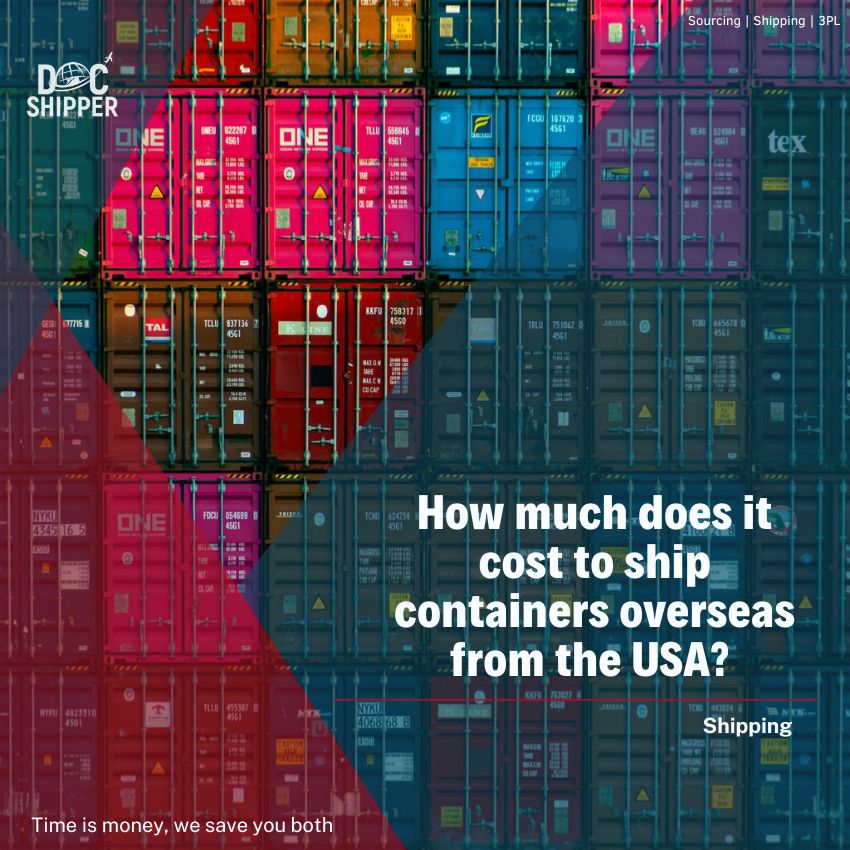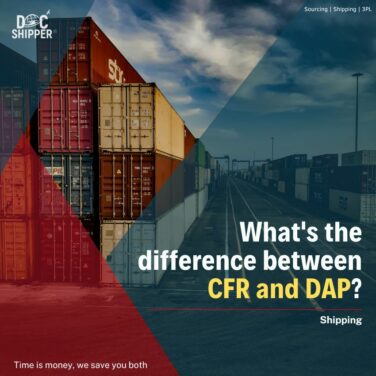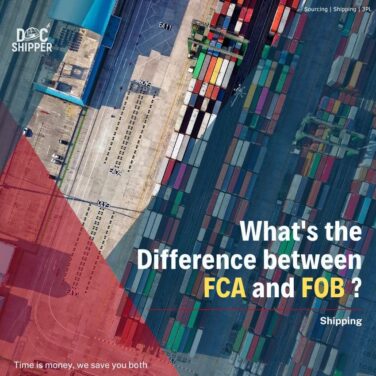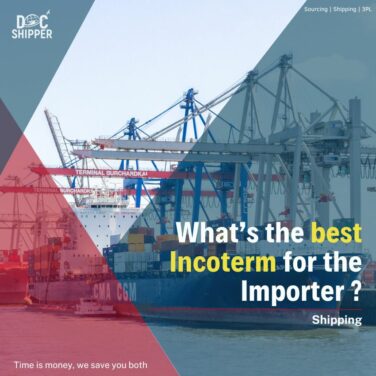Shipping goods overseas can be complex and time-consuming when you aren’t used to doing it. Shipping procedures are long and stressful, and the documentation you have to prepare in both departure and arrival countries can also be very difficult to understand. In addition, an error in these procedures can block your goods at the checkpoint. To make your goods’ shipping easier, Doc Shipper can take charge of the shipping process and guarantee your goods will arrive on time and without any problems. Thanks to this article, you’ll have a clear idea of the costs of shipping a container from the USA to the most popular destinations.
Which container size should I choose?
It exists more than 15 container sizes in the world, but the two you have to know about are the most used: 20ft and 40ft containers. Here is a clear explanation of the differences between these two kinds of containers. If you need to send more voluminous or higher goods, a third part of about 40ft high cube containers is also present.
20ft containers
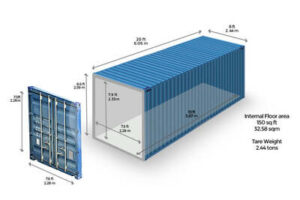
A 20ft container is a shipping container which has the following dimensions :
- Length: 20 feet (5.9 meters)
- Width: 8 feet (2.44 meters)
- Height: 8 feet 6 inches (2.59 meters)
The 20ft container provides a secure and weatherproof enclosure for goods during transportation, protecting them from external elements and ensuring their integrity. Containers of this size are suitable for transporting a variety of goods, including general cargo, consumer goods, machinery, and smaller vehicles.
40ft standard containers
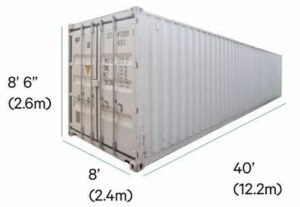 A 40ft container is a shipping container that has the following dimensions:
A 40ft container is a shipping container that has the following dimensions:
- Length: 40 feet (12.2 meters)
- Width: 8 feet (2.34 meters)
- Height: 8 feet 6 inches (2.40 meters)
Like the 20ft container, the 40ft container has standardized dimensions that allow for efficient stacking, loading, and unloading using specialized equipment. It is commonly used for transporting various types of goods, including general cargo, manufactured goods, vehicles, machinery, and larger equipment.
40ft high cube containers 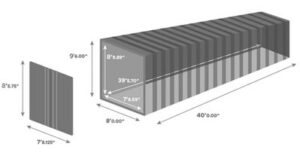
The internal height of a 40ft high cube container is approximately 8 feet 10 inches (or 2.59 meters), providing an additional foot of vertical space compared to a standard container. The increased internal height of a high cube container comes with a slight reduction in payload capacity compared to a standard container, typically around 26-27 metric tons. The higher internal height of a high cube container allows for the transportation of taller or bulkier cargo that may not fit within the confines of a standard container.
DocShipper Tip
DocShipper Advice: It’s worth noting that there are other container sizes available, including 45ft containers and specialized containers designed for specific types of cargo, such as refrigerated containers for perishable goods. To get personalized quote, our customer service is available, contact us or call us!
How are shipping costs calculated?
To make the best choices for your expeditions, it’s important to understand how shipping costs are calculated. The shipping costs depend on the volume and the location. You’ll find below a guide about how costs are calculated.
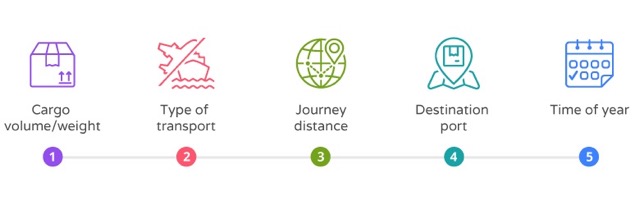
The volume/weight of your pallet
In sea freight, the dimensions of your expedition are the most important, but they can vary depending on the type of freight. If your expedition is bigger, you’ll pay more. In other types, such as air freight, it depends on the weight of your goods. It can be interesting to make estimation with our experts for the two kinds of freight; it can be more interesting to use air freight sometimes.
The shipping distance
As with every kind of freight, the longer your expedition, the more you’ll pay. The fact that you ship port-to-port or door-to-door will also affect the price of your shipment; it’s more expensive to afford a door-to-door shipment, but it also permits you to avoid logistical headaches. The prices can also vary depending on the city; for example, shipping your goods to Melbourne can be more expensive than to Sydney.
DocShipper Info
DocShipper info: It’s complicated to have a clear idea of the price because it depends on several criteria, such as the time of the year. To help you, we can give you a free quote in 24 hours, you just need to complete this form.
Container Shipping rates from the US to Canada
The table below outlines the prices for 20ft and 40ft containers to major ports in Canada. For a free quote specific quote, contact us.
| Port | 20ft container | 40ft container |
|---|---|---|
| Montreal | $2133 | $2829 |
| Vancouver | $4494 | $5960 |
| Halifax | $2000 | $3000 |
Ocean Shipping rates from the US to Mexico
These prices are estimations of the shipping costs from the US to Mexico; to get other propositions, please contact us.
| Port | 20ft container | 40ft container |
|---|---|---|
| Manzanillo | $1123 | $1336 |
| Lazaro Cardenas | $900 | $1316 |
| Ensenada | $1613 | $2006 |
Sea shipping rates from the US to Alaska
The table below outlines the prices for 20ft and 40ft containers to major ports in Alaska. For a free specific quote, please contact us.
| Port | 20ft container | 40ft container |
|---|---|---|
| Anchorage | $3000 | $4000 |
| Cordova | $1500 | $2000 |
| Valdez | $2500 | $3500 |
Container Shipping rates from the US to the UK
The table below outlines the prices for 20ft and 40ft containers to major ports in Alaska. For a free specific quote, please contact us.
| Port | 20ft container | 40ft container |
|---|---|---|
| Immingham | $1150 | $2150 |
| Londres | $2083 | $2627 |
| Southampton | $3250 | $4850 |
Sea shipping rates from the US to Europe
These prices are estimations of the shipping costs from the US to the most popular destinations in Europe. To get other propositions, please contact us.
| Port | 20ft container | 40ft container |
|---|---|---|
| Rotterdam | $1694 | $2152 |
| Le Havre | $1695 | $2150 |
| Barcelona | $2612 | $3412 |
| Hamburg | $1693 | $2152 |
Sea shipping rates from the US to Australia
These prices are estimations of the shipping costs from the US to the most popular ports in Australia. To get other propositions, please contact us.
| Port | 20ft container | 40ft container |
|---|---|---|
| Sidney | $2894 | $3910 |
| Melbourne | $3474 | $4174 |
| Brisbane | $1700 | $4500 |
DocShipper Alert
DocShipper Alert: It’s important to consider that there are several criteria that can impact the price. Moreover, the prices of shipping containers are changing rapidly. For a precise quotation, you may contact us.
The additional costs you could have to afford
For the shipping of your products, you may incur additional costs such as taxes and fees. Here is a non-exhaustive list of the costs that can be added to the shipping costs during your exports.
Customs duties
Customs duties, also known as import duties or tariffs, are taxes imposed by a government on goods that are imported into a country. Customs duties are intended to regulate trade, protect domestic industries, and generate revenue. They are very important and have to be paid; if they aren’t paid, your merchandise could be blocked at the frontier.
You might be interested in this article: How do I clear my goods without a customs broker?
Container inspection fees
Container inspection fees are charges imposed by customs authorities or other regulatory agencies when a shipping container undergoes an inspection. These fees are typically applied to ensure compliance with import/export regulations, verify the contents of the container, and assess any potential risks associated with the cargo. The prevailing MPF (Merchandise Processing Fee) is calculated at 0.3464% of the declared value of the commercial goods. It has a minimum charge of $27.23 and a maximum cost of $528.33 per formal entry.
General rate increase
“General rate increase” (GRI) is a term commonly used in the shipping industry to refer to an across-the-board increase in freight rates charged by shipping lines or carriers. It is a price adjustment applied to the transportation costs of shipping goods by sea.
Inland delivery charges
Inland delivery charges, also known as inland transportation charges or inland haulage charges, are fees associated with the transportation of goods from a port or terminal to the final inland destination. These charges cover the cost of moving the cargo overland, typically by truck or rail, beyond the port or terminal where it arrived.
Quarantine fees
Quarantine fees, also known as biosecurity fees or inspection fees, are charges imposed by authorities or agencies responsible for quarantine and biosecurity measures. These fees are typically associated with the inspection and assessment of goods, animals, or plants to prevent the introduction or spread of pests, diseases, or contaminants. As an example, in Australia, it costs around $300 AUD ($195 USD).
DocShipper Alert
DocShipper Alert: To help you with all these duties and fees, you can contact a customs broker. In addition to the sourcing and the shipping, DocShipper can also take care of this step of your expedition.
FAQ | How much does it cost to ship containers overseas from the USA?
Read more
Looking for more? These articles might interest you:
DocShipper info: Do you like our article today? For your business interest, you may like the following useful articles :
Need Help with Logistics
or Sourcing ?
First, we secure the right products from the right suppliers at the right price by managing the sourcing process from start to finish. Then, we simplify your shipping experience - from pickup to final delivery - ensuring any product, anywhere, is delivered at highly competitive prices.

Fill the Form
Prefer email? Send us your inquiry, and we’ll get back to you as soon as possible.
Contact us







